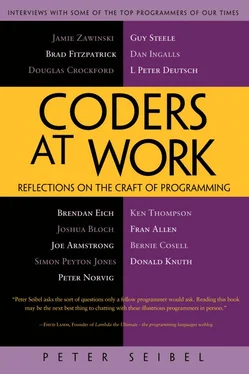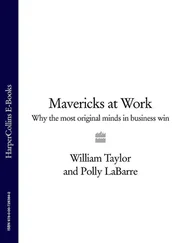Peter Seibel - Coders at Work - Reflections on the craft of programming
Здесь есть возможность читать онлайн «Peter Seibel - Coders at Work - Reflections on the craft of programming» весь текст электронной книги совершенно бесплатно (целиком полную версию без сокращений). В некоторых случаях можно слушать аудио, скачать через торрент в формате fb2 и присутствует краткое содержание. Жанр: Программирование, на английском языке. Описание произведения, (предисловие) а так же отзывы посетителей доступны на портале библиотеки ЛибКат.
- Название:Coders at Work: Reflections on the craft of programming
- Автор:
- Жанр:
- Год:неизвестен
- ISBN:нет данных
- Рейтинг книги:3 / 5. Голосов: 1
-
Избранное:Добавить в избранное
- Отзывы:
-
Ваша оценка:
- 60
- 1
- 2
- 3
- 4
- 5
Coders at Work: Reflections on the craft of programming: краткое содержание, описание и аннотация
Предлагаем к чтению аннотацию, описание, краткое содержание или предисловие (зависит от того, что написал сам автор книги «Coders at Work: Reflections on the craft of programming»). Если вы не нашли необходимую информацию о книге — напишите в комментариях, мы постараемся отыскать её.
Coders at Work
Founders at Work
Coders at Work: Reflections on the craft of programming — читать онлайн бесплатно полную книгу (весь текст) целиком
Ниже представлен текст книги, разбитый по страницам. Система сохранения места последней прочитанной страницы, позволяет с удобством читать онлайн бесплатно книгу «Coders at Work: Reflections on the craft of programming», без необходимости каждый раз заново искать на чём Вы остановились. Поставьте закладку, и сможете в любой момент перейти на страницу, на которой закончили чтение.
Интервал:
Закладка:
Seibel:Is it the kind of thing that you wake up in the morning and you say, “Ah, I’ve got it!” Or is it that you decide to take another run at it and this time you get to the top of the hill?
Peyton Jones:It’s more like that. It’s seldom that I just having a blinding insight in the morning. Another thing that happens as a researcher is you have the opportunity to reflect on what you’ve done and write it up. So quite often if something interesting has happened I try to write a paper about it. So an example of that is there’s a paper called “The Secrets of the GHC Inliner,” which is really a very implementation-oriented paper that describes some implementation techniques that we developed for a particular part of GHC’s innards which we thought might be reusable for others. The chance that you have as an academic is to abstract from the code that, the fourth time around, you’ve finally kicked into a shape that feels good, and write about it so other people can reuse that same technique.
Seibel:What is programming to you? Do you think of yourself as a scientist or an engineer or a craftsman? Or something else entirely?
Peyton Jones:Have you read Fred Brooks’s paper about this, the one called, “The Computer Scientist as Toolsmith”? I reread it recently. It’s very nice. I think it’s good to remember that we’re concerned with building things. I think that’s why programming is so interesting.
At the same time I’m really keen on trying to extract principles of enduring value. I have a paper about how to write a good paper or give a good research talk and one of the high-order bits is, don’t describe an artifact. An artifact is an implementation of an idea. What is the idea, the reusable brainthing that you’re trying to transfer into the minds of your listeners? There’s something that’s useful to them. It’s the business of academics, I think, to abstract reusable ideas from concrete artifacts. Now that’s still not science in the sense of discovering laws. But it is a kind of abstraction into reusable thought-stuff out of the morass of real life that I think is very important.
Seibel:So what about engineering vs. craft. Should we expect to be like the guys who build bridges where, for the most part, bridges don’t fall down? Or are we really more like the guys making pottery—except the pottery is just incredibly complex—where all you can do is apprentice yourself to someone and learn from them how they do it?
Peyton Jones:It’s a bit of a false dichotomy. It’s not truly an either-or choice. One thing that is hard, even for professional software engineers and developers, is to viscerally grok the size of the artifacts on which we work. You’re looking at the Empire State Building through a 1-foot-square porthole, so it’s difficult to have a real feel for how gigantic the structure you’re looking at is. And how it’s interconnected.
How big is GHC? I don’t have a feel for that in the same sense I have a feel for how big this building is. So I don’t think we’re anywhere near where the engineers are with building bridges. Their design patterns have now been boiled down to where they can pretty much be sure that the bridge isn’t going to fall down. We’re nowhere near that with software. But I don’t think that that’s a reason for saying we just shouldn’t worry about it at all.
In fact I think it’s somewhere where functional programming has a lot to offer. Because I think fundamentally it enables you to build more robust structures. Structures that are easier to comprehend and test and reason about. And here is something that I think functional programmers are lagging on: we talk about reasoning about functional programs but we don’t do it very much. I’d like to see much more by way of tools that understand Haskell programs and formally reason about them and give you guarantees beyond their types. We stand on a higher platform and we should be able to go further.
So that’s about saying the material should become more robust. The more robust your materials, the less you need to concentrate on the minutia instead of the larger-scale structures. Of course that will just make us more ambitious to build larger structures until we get to the point where they fall apart again.
I think that’s sort of an invariant. As soon as you can do it, you stretch to the point where you can’t do it anymore. I suppose I don’t really see it as, is it this or is it that? There will always be a strong crafty element, I think, just because we’ll stretch our ambition. In the case of engineering structures, there are physical limits on how far you can stretch. Nobody’s going to build a bridge that traverses the Atlantic any time soon. And that really might fall down if you built it. But that’s not the reason people won’t build it—it’s just because it’d be too expensive. Whereas nowadays, with software, once you can build bridges over the Channel pretty quickly and cheaply, well then, that becomes a done deal and we now think that’s pretty cheap so we’ll now try the Atlantic. And now it falls apart again.
Seibel:Guy Steele was saying how Moore’s Law has been true for his whole career and he suspects it won’t be true for his son’s whole career and was speculating a bit about what that’s going to do to programming. I wonder will we eventually have to stop just saying, “If we can build a bridge over the Channel, we can build one over the Atlantic”?
Peyton Jones:No, no. Software’s different I think. Because if you write software that’s ten times as big that doesn’t mean you have to run it on a computer that’s ten times as fast. The program counter spends its time in a small portion of the code. Ninety percent of its time is spent in ten percent of the code or something. So the parts that are performance critical may be a relatively small part of the program.
It’s true that what tends to happen is you slap abstraction on abstraction on abstraction and before you know it pressing a single button on the screen a great number of things happen all the way down the chain before you finally get to some registers being moved.
So we may have to work on ways of collapsing out those layers by sophisticated compiler transformations so not so much happens. The abstraction boundary may be useful for people but machines don’t care. So I don’t think just because we may reach the boundaries of what computers can do that necessarily software will immediately halt from getting more complicated. Because by that time they’ll be pretty fast anyway. I think the primary limitation on software is not the speed of computers but our ability to get our heads around what it’s supposed to do.
Seibel:What do you enjoy about programming?
Peyton Jones:For me, part of what makes programming fun is trying to write programs that have an intellectual integrity to them. You can go on slapping mud on the side of a program and it just kind of makes it work for a long time but it’s not very satisfying. So I think a good attribute of a good programmer, is they try to find a beautiful solution. Not everybody has the luxury of being able to not get the job done today because they can’t think of a beautiful way to do it.
But I really think it’s a funny medium because it’s so malleable. You can do virtually anything with it. But that means you can build ugly things as well as beautiful things and things that will be completely unmaintainable and undurable. I sometimes feel a bit afraid about the commercial world with, on the one hand, the imperatives of getting it done because the customer needs it next week and, on the other hand, the sheer breadth rather than depth of the systems that we build.
Читать дальшеИнтервал:
Закладка:
Похожие книги на «Coders at Work: Reflections on the craft of programming»
Представляем Вашему вниманию похожие книги на «Coders at Work: Reflections on the craft of programming» списком для выбора. Мы отобрали схожую по названию и смыслу литературу в надежде предоставить читателям больше вариантов отыскать новые, интересные, ещё непрочитанные произведения.
Обсуждение, отзывы о книге «Coders at Work: Reflections on the craft of programming» и просто собственные мнения читателей. Оставьте ваши комментарии, напишите, что Вы думаете о произведении, его смысле или главных героях. Укажите что конкретно понравилось, а что нет, и почему Вы так считаете.












